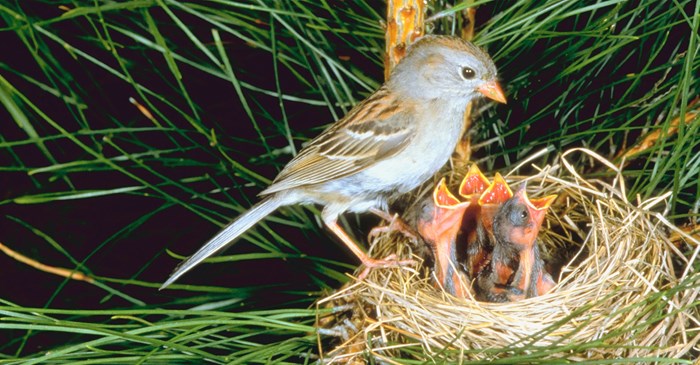In the nest young birds have it easy. Swallows choose to nest inside buildings that have open access so barns stables sheds car ports and even porches all provide suitable protection for their fragile mud nests.
They often seek out dense foliage cavities and niches in trees or perch high in tree foliage and other places where they are away from predators and protected from weather.

Where do songbirds nest. Cues provided by nest predators when available may thus be an important component of nest site selection in songbirds. If you catch birds building in a bad spot your grill over a frequently used door jamb etc you can remove the nesting material and encourage them to try again elsewhere. To avoid losing their entire brood songbird parents try to hustle their adolescents along eventually forcing them from the nest.
Next season you can. When do songbirds fledge the nest. Female songbirds have been shown to eavesdrop on vocalizations of a nest predator and in turn to adjust the location of their nest Emmering and Schmidt 2011 or its degree of concealment by vegetation Eggers et al 2006 in response to perceived nest predation risk.
Cavity nesting birds such as members of the tit family tawny owls and woodpeckers for example may use the same cavity to sleep in overnight as they did for nesting. Other birds construct nests from natural materials such as grass leaves mud lichen and fur or from human-made materials like paper plastic and yarn. These birds called altricial birds will need a little more time to grow until they are ready to leave the nest.
Diurnal birds find safe sheltered places to roost for the night. Precocial birds such as ducks and geese are born with downy feathers open eyes and are ready to run or swim within hours. Still other species prefer the edges between habitat types.
If the nest is completed you can try moving it to a safer spot close by as long as there are no eggs or young in it. Some species will even go so far as to stop feeding their chicks in the nest. These songbirds included species that build open-cup nests either on the ground low down in bushes or higher up in trees as well as species that nest in cavities.
How Do Birds Know How to Build Nests. Woodland birds include chickadees titmice thrushes and warblers. Nests can be found almost anywhere on the ground in trees in burrows on the sides of cliffs in and on human-made structures etc.
It is not illegal to move a non-active nest which is a nest without eggs or young in it. Other altricial birds are the owls hawks and eagles and they are born. When they return to Africa they do not build nests but find safety in numbers in shared roosts often at reedbed sites where they perch together on the reed stems.
Woods attract other species particularly those that eat insects fruits and some seeds. Some birds are born with their eyes closed are bald and helpless and need their parents constant attention. Free food delivered straight to their open mouths fueling their growth.
But the bigger and louder they get and the more time that passes the greater the risk that a predator will discover the nest. Nest site selection may vary as a function of the main nest predator in the system. Some birds do not make nests at all and instead lay their eggs in a simple scrape in the ground.
Northern cardinals like to nest in lower but thickly covered foliage often in saplings and shrubbery such as dogwood spruce and blackberry brambles. They can perch comfortably to rest and roost. Songbirds such as the cardinal wren titmouse woodpecker chickadee and orioles fall into this category.
When nesting season is over nests are a messsplattered in the droppings of the fledglings and in some cases a dead chick. We have a birds nest in the garden constructed from moss and lined soley with black down feathers with an entry hole at the top near to the branch. Most passerines are altricial born bald with closed eyes and totally dependant on their parents.
The nest generally sits in a fork of branches or vines anywhere between 1-15 feet from the ground. Songbirds a species from the oscine ah-SEEN group of passerine PASS-er-een birds songbirds including sparrows thrushes and warblers have a specialized voice box called a syrinx that can produce complex sounds songbirds must learn their songs rather than developing them instinctively have evolved a specialized two-sided vocal organ called the syrinx SEE-rinks the bird voice box. Songbirds are a diverse group that includes species that use a variety of habitats.
Open fields attract many seed-eating species including sparrows blackbirds and finches. However these species usually have a number of possible sites in. Robins sometimes return to a nest for a second season.
An American robins nest built amid the branches of an aspen growing in the Eastern Sierra exemplifies the common cup-shaped nest a type of nest woven by many songbirds using mud grasses twigs feathers and more.
/two-great-tit--parus-major--birds-in-nest-with-eggs--bispgarden--jamtland--sweden-926927334-5b1690661d64040036f9edce.jpg)